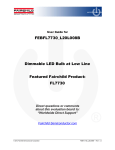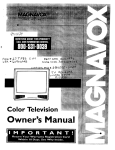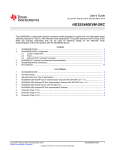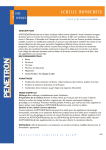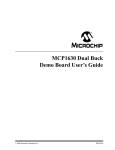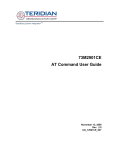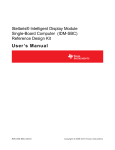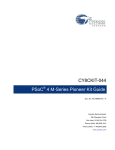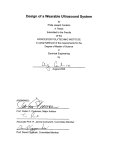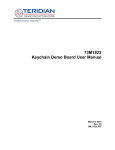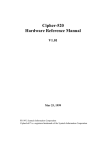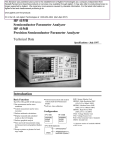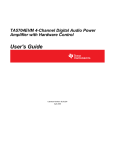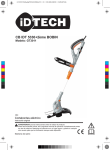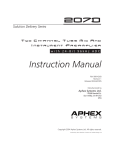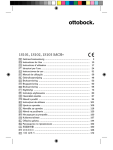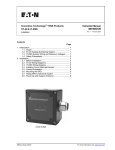Download 73M2901CE Demo Board User Manual
Transcript
Simplifying System IntegrationTM 73M2901CE Demo Board User Manual March 17, 2010 Rev. 1.5 UM_2901CE_026 73M2901CE Demo Board User Manual UM_2901CE_026 © 2010 Teridian Semiconductor Corporation. All rights reserved. Teridian Semiconductor Corporation is a registered trademark of Teridian Semiconductor Corporation. Simplifying System Integration is a trademark of Teridian Semiconductor Corporation. All other trademarks are the property of their respective owners. Teridian Semiconductor Corporation makes no warranty for the use of its products, other than expressly contained in the Company’s warranty detailed in the Teridian Semiconductor Corporation standard Terms and Conditions. The company assumes no responsibility for any errors which may appear in this document, reserves the right to change devices or specifications detailed herein at any time without notice and does not make any commitment to update the information contained herein. Accordingly, the reader is cautioned to verify that this document is current by comparing it to the latest version on http://www.teridian.com or by checking with your sales representative. Teridian Semiconductor Corp., 6440 Oak Canyon, Suite 100, Irvine, CA 92618 TEL (714) 508-8800, FAX (714) 508-8877, http://www.teridian.com 2 Rev. 1.5 UM_2901CE_026 73M2901CE Demo Board User Manual Table of Contents 1 Introduction ................................................................................................................................... 5 1.1 Getting Started......................................................................................................................... 5 1.2 Recommended Operating Conditions and Absolute Maximum Ratings ..................................... 6 1.3 Basic Connections ................................................................................................................... 6 2 3 Design Considerations .................................................................................................................. 7 73M2901CE EVM-600 Demo Board ............................................................................................... 8 3.1 Using the 73M2901CE EVM-600 Demo Board ......................................................................... 8 3.2 73M2901CE EVM-600 Hardware Design ................................................................................. 9 3.2.1 73M 2901CE EVM-600 Schematic Diagrams ............................................................. 9 3.2.2 73M2901CE EVM-600 Demo Board Pin Description ................................................ 12 3.2.3 73M2901CE-EVM-600 Demo Board Bill of Materials ................................................ 14 3.2.4 73M2901CE-EVM-600 Demo Board PCB Layout ..................................................... 15 4 73M2901CE EVM-WW Demo Board............................................................................................. 17 4.1 Using the 73M2901CE0-EVM-WW Demo Board .................................................................... 17 4.2 73M2901CE EVM-WW Hardware Design ............................................................................... 19 4.2.1 73M 2901CE EVM-WW Schematic Diagrams .......................................................... 19 4.2.2 73M2901CE EVM-WW Demo Board Pin Description................................................ 22 4.2.3 73M2901CE EVM-WW Demo Board Bill of Materials ............................................... 24 4.2.4 Recommended Components Used in the Demo Boards ........................................... 25 4.2.5 73M2901CE EVM-WW Demo Board PCB Layout .................................................... 28 5 DC Loop Circuit Schematic ......................................................................................................... 29 6 Related Documentation ............................................................................................................... 29 7 Contact Information..................................................................................................................... 29 Revision History .................................................................................................................................. 30 Rev. 1.5 3 73M2901CE Demo Board User Manual UM_2901CE_026 Figures Figure 1: T73M2901CE Demo Board Basic Connections ......................................................................... 6 Figure 2: 73M2901CE EVM-600 Demo Board Schematic....................................................................... 10 Figure 3: 73M2901CE EVM-600 Motherboard Schematic ...................................................................... 11 Figure 4: 73M2901CE EVM-600 Demo Board Pin Connections ............................................................. 12 Figure 5: 73M2901CE EVM-600 Demo Board: Bottom Layer ................................................................. 15 Figure 6: 73M2901CE EVM-600 Demo Board: Top Layer ...................................................................... 15 Figure 7: 73M2901CE EVM-600 Demo Board: Top Silk Screen ............................................................. 16 Figure 8: 73M2901CE Worldwide Demo Board: Daughter Board Schematic .......................................... 20 Figure 9: 73M2901CE Worldwide Demo Board: Motherboard Schematic ............................................... 21 Figure 10: 73M2901CE Worldwide Daughter Board Pin Connections ..................................................... 22 Figure 11: 73M2901CE Worldwide Demo Board: Bottom ....................................................................... 28 Figure 12: 73M2901CE Worldwide Demo Board: Top Layer and Silk Screen ......................................... 28 Figure 13: Simple DC Loop Simulator .................................................................................................... 29 Tables Table 1: Recommended Operating Conditions ......................................................................................... 6 Table 2: Absolute Maximum Ratings ........................................................................................................ 6 Table 3: Termination Impedance Network Values .................................................................................... 8 Table 4: 73M2901CE EVM-600 Demo Board Description: Digital Interface ............................................ 12 Table 5: 73M2901CE EVM-600 Demo Board: Telephone Network Interface .......................................... 12 Table 6: 73M2901CE EVM-600 Demo Board: DB-25 RS-232 Level Serial Interface ............................... 13 Table 7: 73M2901CE EVM-600 Demo Board Bill of Materials ................................................................ 14 Table 8: S-register Settings for Worldwide Modem Design ..................................................................... 17 Table 9: Termination Impedance Network Values .................................................................................. 17 Table 10: Worldwide Country AC Impedance Requirements .................................................................. 18 Table 11: 73M2901CE Worldwide Demo Board: Digital Interface ........................................................... 22 Table 12: 73M2901CE Worldwide Demo Board: Telephone Network Interface ....................................... 23 Table 13: 73M2901CE Worldwide Demo Board: DB-25 RS-232 Level Serial Interface ........................... 23 Table 14: 73M2901CE Worldwide Demo Board Bill of Materials ............................................................. 24 Table 15: Transformers and Suppliers Tested and Used with the 73M2901CE....................................... 25 Table 16: EMI Inductors for the Tip/Ring Signal Path ............................................................................. 25 Table 17: Recommended PTC Fuses for CPE Applications ................................................................... 26 Table 18: Recommended TVS Over Voltage Protectors ......................................................................... 27 4 Rev. 1.5 UM_2901CE_026 73M2901CE Demo Board User Manual 1 Introduction The Teridian Semiconductor Corporation 73M2901CE Demo Board is a platform for evaluating the 73M2901CE single-chip modem ICs. It incorporates the 73M2901CE integrated circuit, and it has been designed to operate with a PC using the serial COM1 or COM2 RS-232 level ports and standard communications software packages such as HyperTerminal. This document describes the two available demo board configurations, the 73M2901CE-EVM-600 and the 73M2901CE-EVM-WW. The 73M2901CE EVM-600 is a board fitted with 600 Ω resistive termination and is suitable for use in USA and Japan. This board has been designed to comply with U.S. Part 68, USA, and AS/ACIF S002:2001. The 73M2901CE EVM-WW has selectable terminations, which makes it suitable for use in many different countries worldwide. The board has been designed to comply with FCC Part 68, ETSI TS 203, JATE and AS/ACIF S002:2001. 1.1 Getting Started Figure 1 shows the basic connections of the Demo Board. • Use the supplied motherboard and 5 V power supply. • The motherboard includes a 3.3 V regulator to power the 73M2901CE Demo Board. • The motherboard also includes RS-232 level shifters and DCE connector to connect the demo board to a PC or other terminal device. • Use a standard PC terminal emulation program to communicate with the 73M2901CE Demo Board. See the 73M2901CE AT Command User Guide for a complete list of commands. • Type “AT” on the terminal at any speed from 1200 bps to 9.6 Kbps to verify communications with the modem are working correctly. The 73M2901CE modem will return “OK” if communication is properly established. • Connect the RJ-11 connector to a telephone network emulator or private branch exchange (BPX). The demo board, although meeting all the required telecom standards, is not a certified device. Therefore the 73M2901CE Demo Board should not be connected to the outside telephone network. It is not possible to connect two 73M2901CE demo boards back-to-back to test their operation. A DC loop current is needed to activate the network-side circuitry. A simple current-mirror current-source circuit can be used to provide the required DC loop current. A simple circuit is shown in Figure 13. This circuit supplies two independent sources, one for each modem. The loop current provided is approximately 20 mA to each modem. This circuit does not provide network impairments, call progress signals, or attenuation, which are also typically used for modem testing. Rev. 1.5 5 73M2901CE Demo Board User Manual 1.2 UM_2901CE_026 Recommended Operating Conditions and Absolute Maximum Ratings Table 1: Recommended Operating Conditions Parameter Conditions Rating Supply Voltage VDD At the demo board power pins 2.7 to 3.6 VDC Supply Voltage VPC At the mother board power connector 4.75 to 5.5 VDC Ambient Operating Temperature Without condensation or icing -40 °C to +85 °C Input Voltage for Digital Inputs 0 V to VDD + 0.3 V Table 2: Absolute Maximum Ratings Parameter Rating Supply Voltage VDD -0.5 to 4.0 VDC Supply Voltage VPC -0.5 to 6.0 VDC Input Voltage for Digital Inputs -0.3 to (VDD+0.5) VDC Storage Temperature -60 to 150 °C Pin Voltage -0.3 to 5.5 V VDC ESD Tolerance – Other pins +/- 2kV Operation outside these rating limits may cause permanent damage to the device. 1.3 Basic Connections Figure 1: T73M2901CE Demo Board Basic Connections 6 Rev. 1.5 UM_2901CE_026 73M2901CE Demo Board User Manual 2 Design Considerations Keep OSCIN and OSCOUT signals as short as possible and locate the crystal near the pins. Use an 11.0592 MHz parallel mode crystal only. Do not use ground planes under the oscillator circuit since this will increase the parasitic capacitance on the pins. The values of C2 and C3 depend on the load capacitance rating of the crystal that is used, not the 73M2901CE. This load capacitance will typically be between 15 pF and 27 pF, but usually 18 or 22 pF. Parallel resonant crystals are tuned with a specific capacitive load and will be within their specifications when this load is used. This rating is the capacitance measured between the crystal pins including all parasitic capacitances. It is not the values of the capacitors used. The selection of these capacitors can vary with the layout of the PCB, so do not assume the values used with the 73M2901CE demo board are correct for all designs. System noise is the most likely cause of poor Caller ID and low-level receive performance. The lowest amplitude signals that the modem will need to receive are on the order of 5 mV rms. The Caller ID receive levels are also very low due to the requirement to have a high (60 kΩ) AC input impedance while on hook. Having a 20 dB gain boost during Caller ID reception compensates for this, but if there is excessive noise, it will also be amplified. Keeping the analog and digital grounds separate helps control the amount of noise that gets to the receiver input. Dramatic improvements in low-level performance can be gained by proper layout. Keep the VCC trace as short as possible. Make the power trace a minimum of 0.5 mm thick. The analog and digital power and ground should be kept separate for best low receive level performance. Route the power to the digital pins and bypass capacitors on one net and the analog power and VBG bypass pins on another net with inductors separating the two. If power planes are used, separate the power and ground planes so there are separate analog and digital planes for the 73M2901CE. Keep 0.1 µF and 3.3 µF bypass capacitors close to VPD power pins of the device and take other end to the digital ground. Keep 0.1 µF and 10 µF bypass capacitors close to VPA power pin of the device and directly connect the other end to analog ground. Keep all analog signaling away from any high-speed digital circuitry and traces that may be on the board. Observe the separation of the network and modem side circuitry. Maintain at least ¼ inch (6 mm) separation between the two. Do not run power planes under the network side circuitry and maintain the same spacing for the planes from the network. Use only UL, CSA, or TUV approved components that cross the isolation barrier or for network protection to assure compliant performance for the DAA. The transformer used for coupling will have an influence on the values of the components in the DAA circuitry. The winding resistance, inductances and other characteristics of the transformer affect the values of the impedance matching components. Make sure you have the transformer manufacturer’s recommended circuit values when using other transformers. The values can be determined through simulations, but may still require some adjustment to optimize the design. Rev. 1.5 7 73M2901CE Demo Board User Manual UM_2901CE_026 3 73M2901CE EVM-600 Demo Board During the past several years, there have been significant changes to the way telecommunications device certification is handled. Previously you were required to take your new product to an authorized certification laboratory to have certification testing performed. The United States has fundamentally changed their approval procedures for telephone equipment. They have introduced the concept of SDoC (Self-Declaration of Conformity), implying that formal approval of a TCB (Telecommunication Certification Body) is not further necessary. The definition of the technical requirements has been delegated to industry. There is a choice of conformity testing but, in general, the manufacturer or his authorized representative must maintain technical documentation that includes a declaration of conformity and shows how compliance is achieved. It is still a requirement to meet all the same technical requirements for electrical compatibility with the network (TIA/EIA/IS-968 (Part 68) ), electrical safely (UL-60950 power cross) and EMI (Part 15 radiated emissions). Unless you are equipped to perform the tests to verify the operation of your product, it is still prudent to use a third party testing laboratory to assure compliance with applicable regulations. The ACTA (Administrative Council for Terminal Attachments) is the body that now administers the telecom terminal equipment. The FCC is no longer involved in any aspect of the process. The ACTA is a privatized organization and administers all aspects of the telecom equipment. See http://www.part68.org for information on the ACTA. The 73M2901CE Demo Board is designed to meet all the applicable certification regulations defined in those regulations. The 73M2901CE EVM-600 Demo Board design is intended for use in countries that use a 600 Ω resistive termination. Although designed to meet the ACTA defined specifications, the 73M2901CE EVM-600 demo board is not a certified device, and it is therefore not intended for use on the PSTN network. It should only be used in a laboratory environment with network simulation equipment. The network input protection is now standard worldwide, so finding components that that meet UL-60950 Power Cross requirements are not too difficult. Input current limiting and over-voltage protection are both universally required or advised. Self-resetting PPTC fuses are now available that not only protect the product but eliminate the need to replace parts if they are tripped. These protection devices tend to be some of the more expensive components in the design, but to scrimp on these in the initial design can cause problems latter when fixing the problem is more expensive. 3.1 Using the 73M2901CE EVM-600 Demo Board The schematic in Figure 2 shows the design for the 73M2901CE EVM-600 Demo Board. The design uses a “wet transformer” that uses the transformer as the DC load on the line. The advantage to using this topology is that the BOM cost can be lower compared to a “dry transformer” which passes the DC current through an external circuit that simulates an inductor. A dry transformer can be made much smaller, so if small size is important, a dry transformer is preferred. Table 3 shows the termination impedances for 600 Ω resistive as well as ETSI TS 203 and Australian complex impedances. With these three terminations, worldwide terminations impedance requirements can be met. Other demo boards are available to support these other terminations. The 73M2901CE EVM-600 Demo Board uses a wet transformer design that has a 600 Ω resistive termination. Table 3: Termination Impedance Network Values Termination 600 Ohm ETSI TS 203 complex Australia 8 Terminator Component Values 600Ω 750Ω || 150nF + 270Ω 820Ω || 120nF + 220Ω Rev. 1.5 UM_2901CE_026 3.2 73M2901CE Demo Board User Manual 73M2901CE EVM-600 Hardware Design This section includes schematic drawings, PCB layouts and bill of materials for the 73M2901CE 600Ω Demo Board. 3.2.1 73M 2901CE EVM-600 Schematic Diagrams Figure 2 and Figure 3 provide the schematics for the 73M2901CE EVM-600 Demo Board and Motherboard. Rev. 1.5 9 73M2901CE Demo Board User Manual UM_2901CE_026 Figure 2: 73M2901CE EVM-600 Demo Board Schematic 10 Rev. 1.4 UM_2901CE_026 73M2901CE Demo Board User Manual R9 NC VCC RS-232 DB25 J3 C9 0.1uF RI DCD DTR DSR CTS RTS TXD 1 J2 POWER CONNECTOR J1 RJ-11 4 3 2 1 + C6 10uF TP13 V+ R10 0 Ohms RXD 3 2 1 C7 10UF 2 I S O C8 0.1uF 13 25 12 24 11 23 10 22 9 21 8 20 7 19 6 18 5 17 4 16 3 15 2 14 1 5VDC IN 3 1 GND U2 LM3940-3.3 1 IN OUT TP14 GND C1 0.1uF VCC C4 0.1uF 1 2 3 4 5 6 7 8 9 10 11 12 13 14 TP1 RING2 1 1 TP2 TIP2 1 2 3 4 VCC TP3 RING 1 1 RXDB DTRB TXDB RIB DCDB DSRB CTSB RTSB 28 27 26 25 24 23 22 21 20 19 18 17 16 15 J11 CON-10 U1 MAX3237E C1+ C2+ V+ GND VCC C2C1VT1IN T1OUT T2IN T2OUT T3IN T3OUT R1OUT R1IN R2OUT R2IN T4IN T4OUT R3OUT R3IN T5IN T5OUT R1OUTB EN SHDN MBAUD 10 9 8 7 6 5 4 3 2 1 TP4 TIP J7 CON-4 VCC C3 0.1uF C5 0.1uF C2 0.1uF 1 1 TP11 RTS R4 330 R7 330 D1 DTR D2 RTS 1 TP10 RXD R1 330 D3 RXD 1 TP9 TXD 1 TP8 CTS 1 TP7 DCD 1 TP6 1 DSR R5 330 R8 330 R3 330 R6 330 D4 TXD D5 CTS D6 DCD D7 DSR TP5 RI R2 330 TP15 GND 1 VCC TP12 DTR D8 RI Figure 3: 73M2901CE EVM-600 Motherboard Schematic Rev. 1.4 11 73M2901CE Demo Board User Manual UM_2901CE_026 Figure 4: 73M2901CE EVM-600 Demo Board Pin Connections 3.2.2 73M2901CE EVM-600 Demo Board Pin Description Table 4: 73M2901CE EVM-600 Demo Board Description: Digital Interface Name Pin # VCC J1-1 RTS J1-2 CTS J1-3 DSR J1-4 DCD J1-5 RI J1-6 TXD J1-7 DTR J1-8 RXD J1-9 GND J1-10 Description 3.3V power source for the demo board. Request To Send – Low true input. Used for RTS/CTS flow control and V.23 transmission control. Controlled by the Kn command. Clear To Send – Low true output. Used for RTS/CTS flow control and to indicate carrier is being sent in V.23 mode. Controlled by the Kn command. Data Set Ready – Low true output. Indicates the modem is present and ready for use. Data Carrier Detect – Low true output. Indicates a carrier is being received. Controlled by the Cn command. RIng – Low true output. Indicates a valid ring signal is being received. Goes low for the duration the “ring” result code is being sent on RXD. Transmit Digital Input. Pin used as the digital data input for commands and data transmission. Data Terminal Ready – Low true Input. Pin used by the terminal to control certain actions of the modem, such as return to command mode, terminate call, V.23 turnaround, reset, and power down. Receive Digital Output. Pin used as the digital data output for echoing commands and for data reception. Demo board ground. Table 5: 73M2901CE EVM-600 Demo Board: Telephone Network Interface Name TIP 2 TIP RING RING2 12 Pin # J2-1 J2-2 J2-3 J2-4 Description No Connection Polarity independent connection to the telephone network. Polarity independent connection to the telephone network. No Connection Rev. 1.4 UM_2901CE_026 73M2901CE Demo Board User Manual Table 6: 73M2901CE EVM-600 Demo Board: DB-25 RS-232 Level Serial Interface Name TXD RXD RTS CTS DSR DCD DTR RI Rev. 1.5 DB-25pin Description Transmit Digital Inverted Input. Pin used as the digital data input for 2 commands and data transmission. Receive Digital Inverted Output. Pin used as the digital data output for 3 echoing commands and for data reception. Request To Send – High true input. Used for RTS/CTS flow control and 4 V.23 transmission control. Controlled by the Kn command. Clear To Send – High true output. Used for RTS/CTS flow control and to 5 indicate carrier is being sent in V.23 mode. Controlled by the Kn command. Data Set Ready – High true output. Indicates the modem is present and 6 ready for use. Data Carrier Detect – High true output. Indicates a carrier is being 8 received. Controlled by the Cn command. Data Terminal Ready – High true Input. Pin used by the terminal to 20 control certain actions of the modem, such as return to command mode, terminate call, V.23 turnaround, reset, and power down. RIng – High true output. Indicates a valid ring signal is being received. 22 Goes low for the duration the “ring” result code is being sent on RXD. 13 73M2901CE Demo Board User Manual UM_2901CE_026 3.2.3 73M2901CE-EVM-600 Demo Board Bill of Materials Table 7: 73M2901CE EVM-600 Demo Board Bill of Materials Quant Reference Part PCB Footprint DigiKey # Manufacturer # Manufacturer HD04 miniDIP 0805 HD04DITR-ND PCC2182CT-ND HD04 Diodes, Inc. Panasonic PCC270ACVCT-ND PCC330ACVCT-ND PCC1808CT-ND PCC1841CT-ND Panasonic Panasonic Panasonic 3.3µF 0805 0805 0805 0805 0.1µF 0805 PCC1762CT-ND Panasonic 1812 CR1812X7R224ZWT UTC SMB TISP4350T3BJR, TB03100M Bourns, Diodes, Inc Bourns, Raychem 1 2 BR1 C1,C9 1 1 1 3 C2 C3 C4 C5,C12,C13 6 1 C6,C7,C8, C10,C11,C14 C19 1 E1 1 F1 0.22µF Bidirectional Thyristor MF-R015/600 1 1 J1 J2 HEADER 10 HEADER 4 4 1 1 1 1 1 1 1 1 1 10µF 27pF 33pF 47nF L1,L2,L3,L4 NLC322522T-4R7M R1 10K R2 20K R3 5.1K R4 470 R6 21K R9 63K R16 100 T1 MIT4115 U1 2901CE_MLF/TQFP32 1 1 U2 Y1 14 TLP627 11.0592 MHz 200mil T.H. 100 mil, 10 position 100 mil, 4 position 1206 0805 0805 0805 0805 0805 0805 311-10KHCT-ND 311-20KHCT-ND 311-5.1KHCT-ND 311-21KHCT-ND 311-63KHCT-ND 311-100HCT-ND MIT4115 0805 0805 200 mil T.H. TLP627TP1CT-ND CTX409-ND TDK Phicomp Phicomp Phicomp Phicomp Phicomp Phicomp Phicomp Sumida Teridian Semi. Toshiba Rev. 1.5 UM_2901CE_026 73M2901CE Demo Board User Manual 3.2.4 73M2901CE-EVM-600 Demo Board PCB Layout Figure 5: 73M2901CE EVM-600 Demo Board: Bottom Layer Figure 6: 73M2901CE EVM-600 Demo Board: Top Layer Rev. 1.5 15 73M2901CE Demo Board User Manual UM_2901CE_026 Figure 7: 73M2901CE EVM-600 Demo Board: Top Silk Screen 16 Rev. 1.5 UM_2901CE_026 73M2901CE Demo Board User Manual 4 73M2901CE EVM-WW Demo Board It is possible to design a modem that can be used in virtually any country without the need to fit different hardware for different countries’ standards. One of the more significant differences between countries is the line impedance match that is required. This termination can be a concern since poorly matched impedances will affect the network by increasing the reflections and crosstalk. Therefore, there are different terminations required in different countries to match the equipment impedance to the local network’s characteristics. Worldwide countries use three basic network models (see Table 8 and Table 9). In the U.S and North America, a 600 Ω resistive termination is used. Many other counties also use this termination. In most of Europe, the primary termination is a complex AC impedance commonly called “ETSI TS 203”. This is also used in other countries outside of Europe. The third network model is for Australia and New Zealand. There are other concerns such as transmit levels, ring frequencies and levels, call progress tone frequencies and cadence, and network protection. The first four of these are all programmable through the 73M2901CE S-registers. The last can be taken care of by designing for the most stringent specifications. Keep in mind that the overall cost of components will tend to be higher since components with higher ratings will cost more. If Australia and New Zealand are on your list of target countries, then design your protection for them. Australia and New Zealand have higher isolation voltage requirements than other countries (3750VDC) and require that the transformer be encapsulated. Any other devices that cross the isolation barrier, such as opto-couplers, must also meet this requirement. They also have somewhat larger creepage and clearance requirements to match their isolation requirements. The network input protection is now standard, so finding components that that meet worldwide requirements are not too difficult. Input current limiting and over-voltage protection are both universally required or advised. It is possible to pass PTT testing in some cases without current limiting, but you put the integrity and survivability of your product at jeopardy by not using it. Self-resetting PPTC fuses are now available that not only protect the product but eliminate the need to replace parts if they are tripped. 4.1 Using the 73M2901CE0-EVM-WW Demo Board The schematic in Figure 8 shows how to change the termination using the USR pins of the 73M2901CE to control the AC termination network. The user pins control the analog switches that determine the termination impedance. The user pins may have some other defined purposes if certain S register settings are used. Table 8: S-register Settings for Worldwide Modem Design Termination WW DAA 600Ω WW DAA CTR21 WW DAA Australia Initialization String ATS102-3S104-1S95-128S110-64S101+1S101-2S103-1 ATS102-3S104-1S95-128S110-64S101-1S101+2S103-1 ATS102-3S104-1S95-128S110-64S101-1S101-2S103+1 An example of this is the USR11 pin. If the continuous Caller ID mode is selected by setting the MSB of S95, the USR11 pin will toggle during the Caller ID time. If you are using S95 in this mode, you should set the modem termination just before going off hook to assure that you are configured with the correct termination. Table 8 shows the initialization strings needed for the 73M2901CE Worldwide Demo Board. If you choose to rearrange the USR controls in your design, the string settings will of course need to be changed. Table 9: Termination Impedance Network Values Termination 600 Ohm ETSI TS 203 Australia Rev. 1.5 Component Values 600Ω 750Ω || 150nF + 270Ω 820Ω || 120nF + 220Ω 17 73M2901CE Demo Board User Manual UM_2901CE_026 Table 10: Worldwide Country AC Impedance Requirements Country AC Impedance Argentina Australia Austria Bahrain Belgium Brazil Bulgaria Canada Chile China Columbia Croatia CTR/TBR 21 Cyprus Czech Rep. Denmark Ecuador Egypt El Salvador Finland France Germany Greece Guam 600 Aust. Aust. ETSI TS 203 ETSI TS 203 600 Aust. 600 600 600 600 ETSI TS 203 ETSI TS 203 ETSI TS 203 ETSI TS 203 ETSI TS 203 600 600 600 ETSI TS 203 ETSI TS 203 Aust. ETSI TS 203 600 18 Country Hong Kong Hungary Iceland India Indonesia Ireland Israel Italy Japan Jordan Kazakhstan Kuwait Latvia Lebanon Luxembourg Macao Malaysia Malta Mexico Morocco Netherlands New Zealand Nigeria Norway AC Impedance Country AC Impedance 600 600 ETSI TS 203 Aust. 600 ETSI TS 203 ETSI TS 203 ETSI TS 203 600 600 600 600 ETSI TS 203 ETSI TS 203 ETSI TS 203 600 600 ETSI TS 203 600 ETSI TS 203 ETSI TS 203 Aust. ETSI TS 203 ETSI TS 203 Oman Pakistan Peru Philippines Poland Portugal Romania Russia Saudi A bi Singapore Slovakia Slovenia S. Africa S. Korea Spain Sweden Switzerland Syria Taiwan Thailand UAE UK USA Yemen 600 600 600 600 600 ETSI TS 203 600 600 600 600 Aust. ETSI TS 203 ETSI TS 203 600 ETSI TS 203 ETSI TS 203 ETSI TS 203 600 600 600 600 ETSI TS 203 600 600 Rev. 1.5 UM_2901CE_026 4.2 73M2901CE Demo Board User Manual 73M2901CE EVM-WW Hardware Design This section includes schematic drawings, PCB layouts and bill of materials for the 73M2901CE-WW Demo Board. 4.2.1 73M 2901CE EVM-WW Schematic Diagrams Figure 8 and Figure 9 illustrate the schematics for the 73M2901CE EVM-WW Demo Board and Motherboard. Rev. 1.5 19 UM_2901CE_026 VCC3_3D RXDB 57 58 59 DTRB 60 AUST 61 62 RELAY B 63 RIB 64 5 R24 SOIC14 750 3 4 U2C 74LVC4066D 12 C25 120nF 11.0592 MHz R26 C2 VNA RXA VBG VREF TXAP TXAN VPA RESET 48 47 46 45 44 43 42 41 RXA VBG VREF TXAP TXAN RESET 820 C3 VCC3_3A 33 VCC3_3D34 DCDB 35 DSRB 36 CTSB 37 RTSB 38 CTR-2139 US600 40 AUST VPD RXD RXCLK DTR USR20 RING RELAY RI VND VPD DCD DSR CTS RTS USR11 USR10 CTR-21 C20 150nF -All resistors 0603 footprint except R25 which is 1206 Note: Mount J1 and J2 on the BACK of the board -EMIT4033 is required for Austalia only; the non-encapsulated MIT4033 can be used for designs not requiring Austalian operation. 2901CE_QFN/TQFP32 TXCLK TXD VND N/C VPD OSCIN OSCOUT VND U1B 56 55 54 53 52 51 50 49 TXDB -This version supports only: ---Ring-E ---PPU-E ---LIU-E -Keep analog and digital power and ground separate up to J1 connector. -Keep Vref and Vbg traces away from digital traces, especially clocks. Keep traces short and connect Vref and Vbg caps to analog ground. VCC3_3D OSCIN OSCOUT 73M2901CE Demo Board User Manual D3 BZT52C2V4-7-F 10 11 Y1 27pF 33pF U2B 1 74LVC4066D 2 .047uF C27 420 5.1K 2K(NC) RXA VBG VREF TXAP TXAN C4 0.002uF(NC) RESET R25 18 1/4W + C9 10uF C10 0.1uF R16 100 HOOK 10uF + C6 0.1uF R1 10K E C22 3.3uF, 25V C28 220pF, 3kV R8 30K VCC3_3D C5 3.3uF + C15 220pF, 250V U4 TLP627 C1 R12 62K L1 NLV32T-4R7J-PF US600 CTR-21 + R28 47K F1 3 0.1uF D2 MMSZ5248BT 18V 1A 2C B C18 0.22uF 250V -To use the programmable termination: For all: S102-3, S104-1, S95-128, S110-64 600 Ohm termination: S101+1, S101-2, S103-1 CTR-21 termination: S101-1, S101+2, S103-1 Australian termination: S101-1, S101-2, S103+1 2 1 HD04 BR1 R9 30K RING/CIDdetection E1 TISP4350T3BJR Bourns Thy ristor L2 NLV32T-4R7J-PF 4 0.1uF VCC3_3D 1 B Q2 MMBTA06 Q1 VCC3_3D 1 C8 C24 3.3uF VCC3_3A C7 R13 21K R20 20K4A 9C C26 82nF BCP-56 Q3 C21 3.3uF, 25V 4C 2A RING/CID detection 24 23 22 21 20 19 18 17 TXCLK TXD VND N/C VPD OSCIN OSCOUT VND 16 15 14 13 12 11 10 9 7C 3A 3 L4 NLV32T-4R7J-PF VNA RXA VBG VREF TXAP TXAN VPA RESET 74LVC4066D R15 2 VCC3_3A VPD RXD RXCLK DTR USR20 RING RELAY RI VND VPD DCD DSR CTS RTS USR11 USR10 RXDB DTRB TXDB RIB DCDB DSRB CTSB RTSB VCC3_3 25 26 27 28 AUST 29 30 RELAY B 31 32 R2 1 2 3 4 5 6 7 8 10 9 8 7 6 5 4 3 2 1 DCDB J1 U2A + 2 1 2901CE_QFN/TQFP32 MMBTA06 E R27 U1A 4 2 0.1uF L3 NLV32T-4R7J-PF C D1 RS1G T1 Sumida EMIT4033L 3 R17 100 1 0.1uF 2 C14 3.3uF 4 C13 + 13 OSCIN OSCOUT + C12 3.3uF - C11 R23 33K VCC3_3D + VCC3_3D C US600 VCC3_3 C19 C29 220pF, 3kV MF-R015/600 Bourns PTC f use J2 4 3 2 1 RJ-11 0.22uF 250V VCC3_3D Note: A termination MUST be programmed or no termination will be activated. Figure 8: 73M2901CE Worldwide Demo Board: Daughter Board Schematic 20 Rev. 1.5 UG_2901CE_026 73M2901CE Demo Board User Manual TP15 1 VCC VCC 1 + RAPC712 C6 10uF, 10V IN GND 1 2 3 +5VDC C5 0.1uF OUT 3 VCC R10 VCC 0 C9 C7 0.1uF 2 J2 GND 4 U2 LM3940IMP-3.3 C8 10uF C4 0.1uF C10 + 0.1uF U1 10uF, 10V 26 28 25 C1 0.1uF 1 3 R9 24 23 22 19 17 NC NOTE: For 5V operation, R10 is a NC and R9 is 0 Ohm VCC J5 1 2 3 4 5 6 7 8 9 10 RTS CTS DSR DCD RI TXD DTR RXD 16 21 20 18 13 14 15 VCC 2 HEADER 10 (Female) VCC C3 0.1uF VCC C1+ C1- V+ C2+ C2- V- T1IN T2IN T3IN T4IN T5IN T1OUT T2OUT T3OUT T4OUT T5OUT R1OUTB R1OUT R2OUT R3OUT ENB R1IN R2IN R3IN 27 C2 0.1uF 4 J3 1 2 3 4 5 6 7 8 9 10 11 12 13 5 6 7 10 12 8 9 11 14 15 16 17 18 19 20 21 22 23 24 25 DSUB-25 SHDNB MBAUD GND MAX3237 TP1 VCC TP9 1 D1 1 RI TP2 R2 330 RI TIP2 TP10 1 D2 1 DSR TP3 R6 330 DSR TIP TP11 1 D3 1 DCD TP4 R3 330 DCD D4 RING TP12 1 R8 330 CTS 1 CTS TP5 1 D5 TXD TP6 R5 330 TXD 1 D6 RXD TP7 R1 330 RXD 1 D7 RTS TP8 R7 330 RTS RING2 J6 TP13 1 1 2 3 4 5 6 GND TP14 1 J4 1 2 3 4 HEADER 4 (Female) RJ11 modular jack 6 pin GND 1 D8 R4 330 DTR DTR Figure 9: 73M2901CE Worldwide Demo Board: Motherboard Schematic Rev. 1.5 21 73M2901CE Demo Board User Manual UM_2901CE_026 RING GND RXD DTR TXD RI DCD DSR CTS RTS VCC3_3 TIP Figure 10: 73M2901CE Worldwide Daughter Board Pin Connections 4.2.2 73M2901CE EVM-WW Demo Board Pin Description Table 11: 73M2901CE Worldwide Demo Board: Digital Interface Name 22 Pin # VCC J1-1 RTS J1-2 CTS J1-3 DSR J1-4 DCD J1-5 RI J1-6 TXD J1-7 DTR J1-8 RXD J1-9 GND J1-10 Description 3.3 V power source for the demo board. Request To Send – Low true input. Used for RTS/CTS flow control and V.23 transmission control. Controlled by the Kn command. Clear To Send – Low true output. Used for RTS/CTS flow control and to indicate carrier is being sent in V.23 mode. Controlled by the Kn command. Data Set Ready – Low true output. Indicates the modem is present and ready for use. Data Carrier Detect – Low true output. Indicates a carrier is being received. Controlled by the Cn command. RIng – Low true output. Indicates a valid ring signal is being received. Goes low for the duration the “ring” result code is being sent on RXD. Transmit Digital Input. Pin used as the digital data input for commands and data transmission. Data Terminal Ready – Low true Input. Pin used by the terminal to control certain actions of the modem, such as return to command mode, terminate call, V.23 turnaround, reset, and power down. Receive Digital Output. Pin used as the digital data output for echoing commands and for data reception. Demo board ground. Rev. 1.5 UM_2901CE_026 73M2901CE Demo Board User Manual Table 12: 73M2901CE Worldwide Demo Board: Telephone Network Interface Name TIP 2 TIP RING RING2 Pin # J2-1 J2-2 J2-3 J2-4 Description No Connection Polarity independent connection to the telephone network. Polarity independent connection to the telephone network. No Connection Table 13: 73M2901CE Worldwide Demo Board: DB-25 RS-232 Level Serial Interface Name TXD RXD RTS CTS DSR DCD DTR RI Rev. 1.5 DB-25pin Description Transmit Digital Inverted Input. Pin used as the digital data input for 2 commands and data transmission. Receive Digital Inverted Output. Pin used as the digital data output for 3 echoing commands and for data reception. Request To Send – High true input. Used for RTS/CTS flow control and 4 V.23 transmission control. Controlled by the Kn command. Clear To Send – High true output. Used for RTS/CTS flow control and to 5 indicate carrier is being sent in V.23 mode. Controlled by the Kn command. Data Set Ready – High true output. Indicates the modem is present and 6 ready for use. Data Carrier Detect – High true output. Indicates a carrier is being 8 received. Controlled by the Cn command. Data Terminal Ready – High true Input. Pin used by the terminal to 20 control certain actions of the modem, such as return to command mode, terminate call, V.23 turnaround, reset, and power down. RIng – High true output. Indicates a valid ring signal is being received. 22 Goes low for the duration the “ring” result code is being sent on RXD. 23 73M2901CE Demo Board User Manual UM_2901CE_026 4.2.3 73M2901CE EVM-WW Demo Board Bill of Materials Table 14: 73M2901CE Worldwide Demo Board Bill of Materials Quant Reference Part DigiKey # Manufacturer P/N Manufacturer 1 BR1 HD04 HD04DICT-ND HD04-T Diodes, Inc. 2 1 C1,C9 C2 10µF 27pF 587-1295-1-ND PCC270ACVCT-ND EMK212BJ106KG-T ECJ-1VC1H270J Taiyo Panasonic 1 0 4 C3 R2,C4 C5,C12,C13,C24 33pF NC PCC330ACVCT-ND ECJ-1VC1H330J Panasonic 3.3µF Cer. PCC2288CT-ND ECJ-2FB1A335K Panasonic 2 C21,C22 3.3µF, 25V 399-3140-1-ND C1206C335K3PACTU Kemet 6 C6,C7,C8,C10,C11,C14 445-1314-1-ND C1608X7R1H104K TDK 1 C15 0.1µF 220pf, 250V (min.) 445-2338-1-ND C3216COG2J221J TDK 2 C18,C19 0.22µF, 200V 490-3544-1-ND GRM43DR72E224KW01L Murata 1 C20 0.15µF (150nF) PCC1748CT-ND ECJ-1VB1A154K Panasonic 1 C25 0.12µF (120nF) PCC1906CT-ND ECJ-1VB1A124K Panasonic 1 C26 0.082µF (82nF) PCC2280CT-ND ECJ-1VB1E823K Panasonic 1 C27 0.047µF PCC1758CT-ND ECJ-1VB1C473K Panasonic 2 1 2 C28, C29 D1 D2 220pF, 3kV Rectifier, 1A, 400V 18V Zener Diode C4532COG3F221K RS1G-13-F MMSZ5248BT1G TDK Diodes, Inc. ON 1 1 D3 E1 2.4V Zener Diode Thyristor, 270V 250A 445-2380-1-ND RS1G-FDICT-ND MMSZ5248BT1GOSCTND BZT52C2V4-FDICT-ND P3100SBLRPCT-ND 1 F1 1 1 4 2 J1 J2 L1,L2,L3,L4 Q1,Q2 PPTC Fuse, 150mA, 600V HEADER 10 HEADER 3 NLV32T-4R7J-PF MMBTA06 Diodes, Inc. Teccor Elect., Bourns Rachem, Bourns Sullins Sullins TDK ON 1 1 2 Q3 R1 R8,R9 BCP-56 10K 30K S1011E-36-ND S1011E-36-ND 445-1521-1-ND MMBTA06LT1GOSCTND BCP56T1GOSCT-ND P10.0KHCT-ND P30KGCT-ND BZT52C2V4-7-F P3100SBLRP, TISP4350T3BJR TRF600-150, MF-R0150/600 PBC36SAAN PBC36SAAN NLV32T-4R7J-PF MMBTA06LT1G BCP56T1G ERJ-3EKF1002V ERJ-3GEYJ623V ON Panasonic Panasonic 1 1 1 2 1 1 R12 R13 R15 R16,R17 R20 R23 62K 21K 5.1K 100 20K 33K P62KGCT-ND P21.0KHCT-ND P5.1KGCT-ND P100HCT-ND P20KGCT-ND P33KGCT-ND ERJ-3GEYJ303V ERJ-3EKF2102V ERJ-3GEYJ512V ERJ-3EKF1000V ERJ-3GEYJ203V ERJ-3GEYJ333V Panasonic Panasonic Panasonic Panasonic Panasonic Panasonic 1 1 1 1 1 1 1 1 1 1 R24 R25 R26 R27 R28 T1 U1 U2 U4 Y1 750 18 820 422 47K See Table 15* 2901CE_QFN/TQFP32 74LVC4066D-T TLP627(F,T) 11.0592 MHz P750GCT-ND P18ECT-ND P820GCT-ND P422HCT-ND P47KGCT-ND ERJ-3GEYJ751V ERJ-8GEYJ180V ERJ-3GEYJ821V ERJ-3EKF4220V ERJ-3GEYJ473V 74LVC4066D-T-ND TL627F-ND CTX409-ND TLP627(F,T) or SD400 ATS111 Panasonic Panasonic Panasonic Panasonic Panasonic See Table 15* Teridian NXP TOSHIBA CTS TRF600-150-ND * Equivalent parts are available from Datatronics, Sumida, Umec, and Allied. 24 Rev. 1.5 UM_2901CE_026 73M2901CE Demo Board User Manual 4.2.4 Recommended Components Used in the Demo Boards Several components are required in all modem designs that significantly affect the total BOM cost. The following parts and suppliers have proven to supply reliable and cost effective components. Table 15: Transformers and Suppliers Tested and Used with the 73M2901CE Manufacturer Allied Datatronics Etal Sumida Wurth-Midcom Umec “Wet” Transformers (DC Current OK) AEE-208D1 LM72019 None currently available MIT4115V 671-8001, 671-8005 None currently available “Dry” Transformers (No DC Current) AEE-207D1, AEP-322D1 PT79281 P1200 MIT4033L, T50101 671-8236-MU/-LF1 UTB01542 The transformers listed in Table 15 are used in the 73M2901CE Demo Boards. The transformers listed as “wet” are suitable in applications that pass the DC current through the transformer windings. These transformers are physically larger than the “dry“ types in order to prevent saturation with DC current, and generally have lower return loss performance. These are used in the EVM-600 type designs. The “dry” transformers require a separate DC holding circuit or gyrator (Q1-Q3 and associated circuitry in Figure 8) to provide a DC load to the network. This circuit is also used for pulse dialing (when required), and must present a high AC impedance to the line so that AC audio performance is not compromised. These transformers are used on the 73M2901CE EVM-WW Demo Boards. The Tip/Ring inductors on the demo board are 4.7uH and are used to control EMI that might be coupled out to the line. Inductors that are intended for EMI control applications are sometimes rated for a particular impedance at some frequency, e.g., 2 kΩ at 100 MHz. Since the telephone connections also carry DC current, these inductors must also work with the DC current that may be present. All inductors in the Tip/Ring path must be rated to operate with a minimum of 200 mA so that performance is not overly degraded at high frequencies by core saturation. Inductance also tends to go down with temperature, so this must also be factored into the component selection. The actual EMI frequencies and levels that must be controlled are not always the same since EMI generated in any part of the design can end up being radiated from the telephone connection, so some characterization of the emissions is needed to determine the best fit for the frequencies that are present. The parts we use have good characteristics for the board when used alone, but may not work in every application that is encountered. Inductors can have a wide range of impedance versus frequency depending on the materials that are used, so there cannot be “one size fits all” solution for every application. Be sure the inductors are not located between the Tip and Ring connection and the over voltage/over current protection in the design. You do not want to have the surge current and voltage across these devices! Table 16 contains some inductors that might be used in your application. Table 16: EMI Inductors for the Tip/Ring Signal Path Manufacturer Allied Laird (Steward) TDK Part Number MC20A-4R7M-RC HZ0805C202R-00 NLV32T-4R7J-PF Value, µH or Z @ Freq. 4.7 µH 2 kΩ @ 100MHz 4.7 µH Rated Current 220 mA 300 mA 220 mA There are high voltage capacitors connected to Tip and Ring to earth ground that also aid in limiting EMI to the outside connections. These must have the same voltage ratings as the isolation required for the design (i.e., normally the transformer isolation voltage rating). There is also a capacitor across the Tip/Ring path that acts as a shunt to EMI energy coming from the DAA. The voltage rating of this part only needs to be high enough to tolerate voltages up to the TVS clamp voltage (see the over voltage protection section that follows). Rev. 1.5 25 73M2901CE Demo Board User Manual UM_2901CE_026 If TVS devices are also provided on the Tip and Ring lines to earth ground, the voltage rating for the Tip/Ring capacitors only needs to be able to withstand the maximum TVS clamping voltage. These and the TVS devices must be removed during the isolation voltage certification tests to prevent triggering the TVS devices or damaging the capacitors. Over voltage and current protection are required for a reliable design that will survive the real-world conditions that are encountered in the field. Nearly all certifying bodies have specifications for the severe conditions that can occur due to lightning, static discharge, and even voltage cross to power mains. In some cases these minimums are not adequate to survive some common fault conditions or ignore other conditions that would seem to be less severe, but actually can present more stress to the design, so many equipment providers will have even higher level or additional requirements not specified by the certifying bodies. For example, the minimum isolation voltage required for the telecom transformers is 2 kV, but lightning strikes near power and telephone lines often far exceed these levels. For these reasons, some customers require 6kV or more isolation. Protection from the telephone network connection is usually provided to prevent over voltage and over current conditions from causing the product to fail. The PTC (Positive Temperature Coefficient) fuse (F1) and thyristor Transient Voltage Suppressor or TVS (E1) provide this protection on our demo boards. The devices we chose are parts that meet the minimums required for UL 60950 and EN-60950, which have the most stringent requirements of the commonly used standards. The 73M2901 designs are fully functional after the surge and power cross testing has been performed, even though this is not a requirement to pass, (the requirement for off hook is that it not catch fire). The following tables show the recommended components to meet various certification requirements. The PTC fuses listed are through-hole mounted, but surface mount is also available for most types. There are also different initial “ON” resistance versions that primarily affect the cost; the lower the initial resistance, the higher the cost. There are also single fault telecom fuses that are designed to be used in these applications, but they must be replaced if they are triggered. The cost of these is about the same or more compared to the PTC types, so there is little advantage to using them in most cases. Table 17: Recommended PTC Fuses for CPE Applications Manufacturer Bourns Thinking Electronic Ind. Co. Tyco (Raychem) Part Number MF-R015/600 MF-RX012/250 KRT6000015xxx KRT2500012xxx TRF600-150 TRF250-120x Voltage/Current Rating 600V, 150mA 250V, 120mA 600V, 150mA 250V, 120mA 600V, 150mA 250V, 120mA Specification TIA-968-A, UL60950 ITU-T K.20/21/45 TIA-968-A, UL60950 ITU-T K.20/21/45 TIA-968-A, UL60950 ITU-T K.20/21/45 The TVS is important because large voltages can damage the DAA if the DAA transistor switches’ voltage ratings are exceeded. The TVS works in conjunction with the PTC fuse by going into a low impedance state when the TVS are triggered, which then causes the fuse to go to a high impedance until the fault condition is cleared. This prevents the TVS from having to dissipate large amounts of energy if there is a persistent high voltage fault. The TVS will also be triggered for short duration surges, but this will usually not trigger the fuse since it may take seconds for the fuse to go to the high impedance mode, depending on the current through it. In any case, these components work as a “team” to protect the DAA circuitry. 26 Rev. 1.5 UM_2901CE_026 73M2901CE Demo Board User Manual Table 18: Recommended TVS Over Voltage Protectors Manufacturer Bourns Part Number TISP4395T3BJR Voltage/Current Rating 275V/100A (10/560µS) Diodes, Inc TB3100H 275V/100A (10/560µS) Littlefuse (SIDACtor) P3100EB 275V/100A (10/560µS) Tyco SiBar TVB275NSC 275V/100A (10/560µS) Specification TIA-968-A, UL60950 ITU-T K.20/21/45 TIA-968-A, UL60950 ITU-T K.20/21/45 TIA-968-A, UL60950 ITU-T K.20/21/45 TIA-968-A, UL60950 ITU-T K.20/21/45 It is not a requirement to function after the safety testing has been performed as long as there is not a hazardous condition afterwards. If this is not a primary concern, it is possible to pass these tests with less expensive protection solutions. This usually involves supplying a heavier gauge telephone cord and TVS that replace the ones above. It also requires mounting in a fire enclosure to contain any resultant fire and damage. This is a choice that the designer (and buyer) must make when deciding on the end product’s requirements. The recommendations listed should not be construed as the final word on components that can be used with Teridian’s products. Other sources exist that we have not had experience with that could also be used in applications with our modem and FXO devices. The customer is encouraged to investigate other sources of parts that are not listed here. Rev. 1.5 27 73M2901CE Demo Board User Manual UM_2901CE_026 4.2.5 73M2901CE EVM-WW Demo Board PCB Layout Figure 11: 73M2901CE Worldwide Demo Board: Bottom Figure 12: 73M2901CE Worldwide Demo Board: Top Layer and Silk Screen 28 Rev. 1.5 UM_2901CE_026 73M2901CE Demo Board User Manual 5 DC Loop Circuit Schematic The following circuit can be used to connect two modems for back-to-back testing. Most modems require DC loop current is present for the DAA to operate correctly. Generally they cannot be connected together directly without some provision for providing this current. The following circuit can be used for this purpose. This circuit also provides a termination impedance that is close to the 600 Ohms used in the U.S.and many other countries. +12V +12V R6 10 OHM Q4 2N2905 R4 10 OHM R1 10 OHM Q3 2N2905 Q1 2N2905 R5 690 OHM R3 10 OHM Q2 2N2905 R2 690 OHM J2 J1 C2 + 22UF 50 V C1 + 1 2 3 4 22UF 50 V RJ-11 1 2 3 4 RJ-11 Figure 13: Simple DC Loop Simulator 6 Related Documentation The following 73M2901CE documents are available from Teridian Semiconductor Corporation: 73M2901CE Data Sheet 73M2901CE AT Command User Guide 7 Contact Information For more information about Teridian Semiconductor products or to check the availability of the 73M2901CE, contact us at: 6440 Oak Canyon Road Suite 100 Irvine, CA 92618-5201 Telephone: (714) 508-8800 FAX: (714) 508-8878 Email: [email protected] For a complete list of worldwide sales offices, go to http://www.teridian.com. Rev. 1.5 29 73M2901CE Demo Board User Manual UM_2901CE_026 Revision History Revision Date Description 1.0 11/12/2008 Created from a merge of the USA (version 1.2) and Worldwide (version 2.1) DBUM documents. Modified to use new corporate format and assign a Document Number. Section on the AT Command has been moved to its own document (UM_2801CE_027). 1.1 2/19/2009 In Table 8, corrected the entries for WW DAA CTR21 and WW DAA Australia. 1.2 8/7/2009 Replaced the Daughter Board schematic in Figure 8. 1.3 10/1/2009 Fixed the corrupted schematics in Figure 2 and Figure 8. 1.4 1/15/2010 Replaced the schematic in Figure 9 with a new schematic. Removed Section 5 (the 73M2901CE/CL differences were moved to the 73M2901CE Data Sheet) and subsequent sections were renumbered. 1.5 3/17/2010 Updated the schematic in Figure 8. Replaced the layouts in Figure 10, Figure 11 and Figure 12. Updated the Bill of Materials in Table 14. Updated the first part of Section 4.1. Added Section 4.2.4, Recommended Components Used in the Demo Boards. 30 Rev. 1.5






























